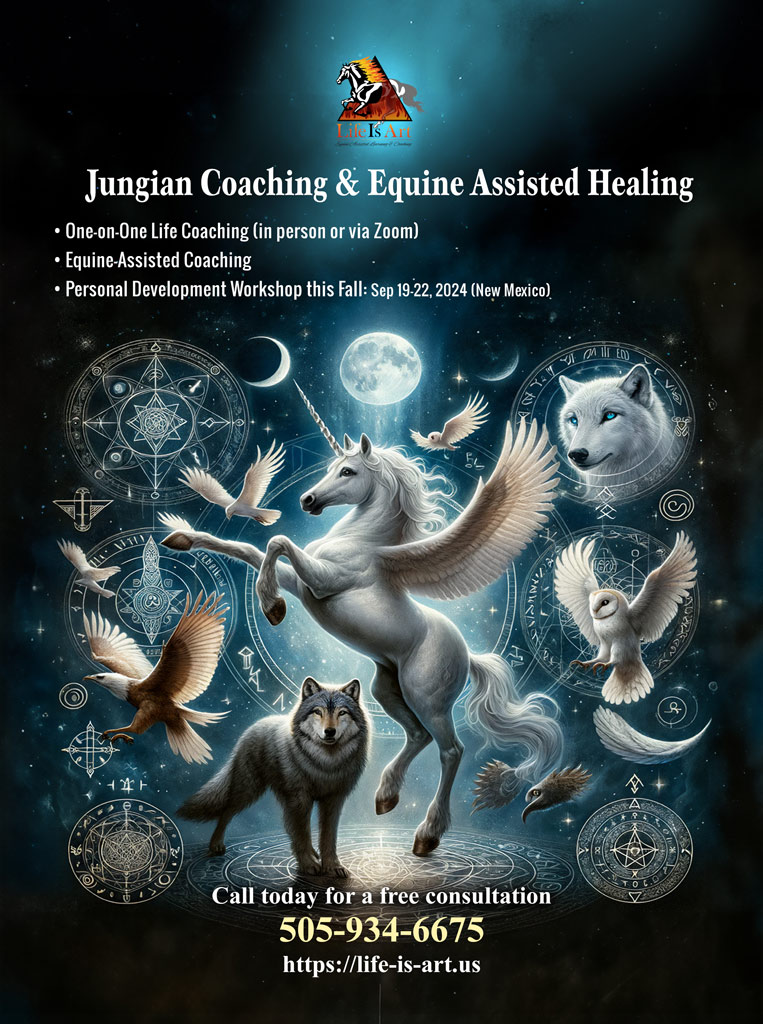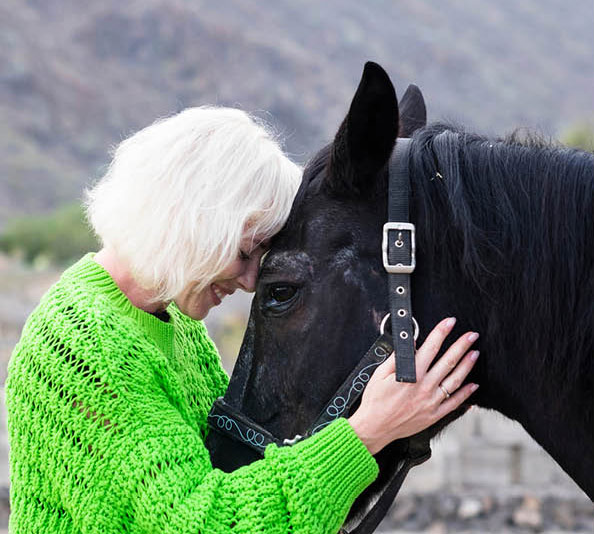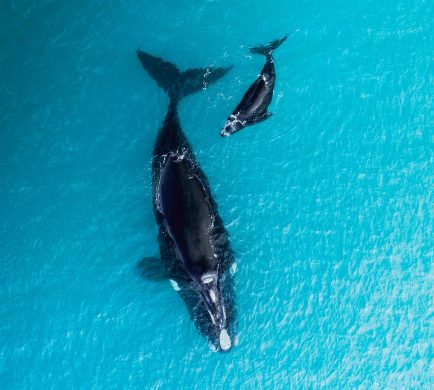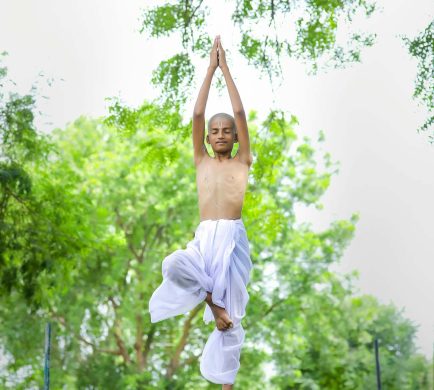In honor of Mental Health Awareness Month, I’d like to write about the growing field of equine-assisted interventions (EAI) for self-development and mental health. According to PATH International, “Partnering with horses can have a major physical and emotional impact on people with a wide variety of physical disabilities, cognitive delays, or emotional challenges” (https://pathintl.org/benefits-of-eas/). The field of EAI began with a focus on “riding for the handicapped,” or therapeutic riding, as an effort to help in the lives of individuals suffering from physical and cognitive disabilities. In the 1990s, EAIs began their evolution into the fields of learning and psychotherapy.
The learning piece is designed with personal growth and development in mind and helps people in building skills related to creativity, problem-solving, decision-making, communication, leadership, and self-esteem. In my own EAL (equine-assisted learning) practice, I utilize a Jungian coaching model to help clients explore the more unconscious aspects of the self and integrate the learnings offered by the horses into conscious awareness. In my experience, both personally and as a coach, I see the horse-human bond through an alchemical lens. I view the horse as the alchemist that can help us catalyze what is dormant -the great potential of our human life- into a process of self-actualization and destiny-building. Different EAL practitioners focus on different areas of interest, such as leadership and professional development, alongside the many dimensions of self-inquiry. While most EAL practitioners hold credentials from reputable organizations that uphold standards and best practices, it is important to note that this is not a regulated field.
Unlike EAL, equine-assisted mental health (EAMH) requires someone who is licensed or under the supervision of a licensed mental health practitioner, working either alone, if they have equestrian skills, or in partnership with an equine expert. To give the reader a well-informed overview of the benefits of EAMH, I interviewed Rebecca Wara-Goss, LMFT, PhD, PATH Intl. CTRI and ESMHL, an EAMH expert who is executive director of Eudaemonia Equine Connections Inc., a 501(c)(3) non-profit in the Portland, Oregon area (www.equineconnections.org ). The mission of the non-profit is to provide EAMH treatment services, raise awareness of the benefits of this modality, and expand access to this type of therapy by offering affordable options for patients.
I started our conversation by asking Dr. Wara-Goss about the differences between traditional forms of psychotherapy and the equine-assisted model. She mentioned that traditional forms of counseling, such as Cognitive Behavioral Therapy (CBT), Dialectical Behavioral Therapy (DBT), Motivational Interviewing, and EMDR (Eye Movement Desensitization and Reprocessing), among others, are evidence-based practices. They have had enough research to earn the buy-in of the “powers that be” in the psychology treatment world of the United States, which transfers to the rest of the world. Dr. Wara-Goss says that “a major difference with equine mental health treatment is we do not have any evidence-based modality. It creates problems because it makes it seem like it’s alternative or like a CAM-type approach, which is complementary and alternative medicine approaches. It’s a little more fringe.” Dr. Wara-Goss also talks about the change that needs to happen to integrate equine-assisted mental health treatment into the mainstream science world and into the “science plus insurance” world to help cover services. She says that “essentially, humans have this schema and this archetype that counseling is done inside while the client is lying on a couch and the therapist is sitting behind them taking notes. Now we have adaptable client-centered treatment approaches.”
My second question had to do with understanding what the horse partner brings to the table -what does the horse have access to that the human therapist may lack? Dr. Wara-Goss explains that “with a human therapist, there’s a lot of masking that we do. And humans tend to be, for the most part, very private when they have issues. It takes time to develop trust and rapport in traditional counseling because of that masking and because of the vulnerability involved.” Dr. Wara-Goss says that in her experience, “in traditional counseling, it probably takes five to six sessions before the client may start to feel the benefit of therapy and may start to feel a little more relaxed with the process.” In contrast, when it comes to equine therapy, she says that “because horses have the ability to just stir stuff up, the rapport can go a lot faster.”

When a person feels comfortable with a horse, they start to form an emotional bond and connection, and a story or narrative emerges. This therapeutic alliance can develop quicker with a horse than with a human therapist. Because horses are non-verbal, a deeper connection and understanding are required on the part of the client. Dr. Wara-Goss also remarked on something that probably most horse people intuit and the old cowboys and cowgirls have always known -you can’t hide when you are around a horse; you can’t mask it: “They sense it to the core of a human being. We have tons of extrapolation and ideas about why. Like, oh, it’s because they have a big nervous system or because they’re a prey animal, and we’re a predator on two feet with two forward eyes. There are all sorts of extrapolations as to why that is. But we don’t always have to know the why. It just it happens.” This idea that a horse can unmask us is very powerful, and this conversation brought to my awareness all the times in my life that horses have brought me and my clients into a place of authenticity. Horses can also be especially effective at providing a sense of safety during those moments of exposure.
In our interview, I asked Dr. Wara-Goss to talk a bit about the use of equine-assisted interventions in the treatment of PTSD in military veterans, a population she has worked extensively with and which was also a focus of her doctoral research. In her experience, military PTSD (a term she created for her dissertation) is a unique and very intense experience stemming from two root issues. For one, there is desensitization of the individual and the development of a group or institutional mentality. The military mindset is all about “their buddies,” who now become their families -it is a system where it’s easy to lose yourself. Dr. Wara-Goss reminds us that PTSD can develop from combat and non-combat experiences, such as witnessing horrible things and survivor guilt.
Secondly, as she says, “Many soldiers are tough; they are taught not to feel pain and to battle through everything. Just put your head down and battle through it. So, they are experts in masking how they really think and feel.” Although opening up too quickly can be a tricky situation, especially when the PTSD takes the veteran back to a lived experience, Dr. Wara-Goss says that the “super activation that horses do is a phenomenon of opening our hearts and healing the stuff that comes through, and that release can be pretty powerful.” Many times, veterans will also identify with the horse as their “battle buddy”, and they develop a great degree of caring for and bond with the horse.
Lastly, I asked Dr. Wara-Goss if there are mental health conditions that respond better than others to equine-assisted interventions. She noted that pretty much any condition can be treated when horses are involved, and she has had excellent results with those suffering from what she calls the “holy triangle” of trauma-anxiety-depression: “With anxiety, the goal is always to reduce the symptoms. And with depression, it’s always increasing mood and stabilization. And then with trauma, it’s a lot more complicated, but it’s going to be that combo, both of reducing hyperarousal but increasing sense of self, increasing positivity, and increasing healing in support of psychological wellbeing.” Dr. Wara-Goss also mentions that working with horses can be a very successful strategy to reach youth, who usually don’t respond well to therapy because they’re usually a mandated client. Regardless of age group, EAMH can be a great secondary option for anyone who does not respond or does not do well in traditional counseling.
And, of course, in this conversation, Dr. Wara-Goss and I touched on the important topic of somatics and how we hold experiences in our body. Groundbreaking research in the field of trauma, especially the work of Peter Levine and Bessel van der Kolk, has brought about the development of evidence-based, body-centered therapies as key to liberating and processing traumatic experiences. Integrating horses in therapy is a great way to bring the body into conscious awareness. The nature of our activities with horses is very “touchy-feely,” and just being around these big guys forces us to be aware of our own bodies. It is an excellent mechanism for improving our mind-body connection.
Lastly, I’d like to share some resources for our readers if anyone is interested in learning more about the benefits of equine-assisted mental health and learning options and the research behind it:
https://horsesformentalhealth.org/how-horses-help/#why
https://www.psychologytoday.com/us/therapy-types/equine-assisted-therapy







